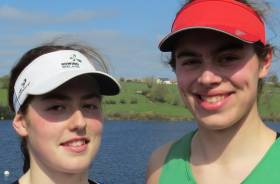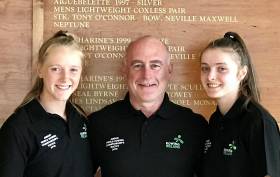Displaying items by tag: World Junior Championships
Fifth for Ireland at World Junior Championships
#Rowing: Ireland’s Molly Curry and Rhiannon O’Donoghue finished fifth in the junior double at the World Rowing Junior Championships in Tokyo. The race was won by the outstanding Lisa Bruijnincx and Jacobien van Westreenen of the Netherlands. The Dutch pushed China into second. Behind them Germany lost out to Lithuania in the battle for bronze.
Curry and O’Donoghue initially fought it out with Greece for fifth. They won this battle and made up metres on Germany, but could not quite push into the battle for medals.
World Rowing Junior Championships, Tokyo, Day Five (Irish interest)
Men
Junior Four, coxed – A Final: 1 Germany 6:32.41, 2 South Africa 6:32.71, 3 China 6:33.90; 4 Ireland (J O’Donovan, M Gallagher, J Dorney, J Kearney; cox: L O’Regan) 6:34.82.
Women
Junior Double Sculls – A Final: 1 Netherlands 7:25.50, 2 China 7:27.66, 3 Lithuania 7:30.23; 5 Ireland (R O’Donoghue, M Curry) 7:38.08
Ireland Coxed Four Denied Bronze at World Junior Championships
#Rowing: Ireland’s junior men’s coxed four took fourth place at the World Junior Championships in Tokyo this morning.
The Ireland crew of James O’Donovan, Matthew Gallagher, Jack Dorney, John Kearney and cox Leah O’Regan came in just under a second short of the bronze medal slot.
Germany judged the race best of all. China, Ireland and South Africa were the top crews to the 1,000 metres, with China taking over a slim lead from their two rivals. Even as the Chinese tried to extend their advantage, Germany closed on all three crews. They produced a remarkable final 500 metres to sweep into the lead. South Africa took the silver and China just held out to take the bronze.
World Rowing Junior Championships, Tokyo (Irish interest)
Men
Junior Four, coxed – A Final: 1 Germany 6:32.41, 2 South Africa 6:32.71, 3 China 6:33.90; 4 Ireland (J O’Donovan, M Gallagher, J Dorney, J Kearney; cox: L O’Regan) 6:34.82.
Ireland's Curry and O'Donoghue Qualify for A Final in Tokyo
#Rowing: Ireland’s Rhiannon O’Donoghue and Molly Curry will compete in the A Final of the junior double sculls at the the World Junior Championships in Tokyo on Sunday. The Ireland crew took a clear third place in their semi-final this morning.
The Netherlands were impressive winners, while Lithuania raced well to take second. Ireland pulled clear of Belgium to sit in a qualification spot at 1500 metres. Italy pushed hard coming to the line, but they could not overhaul the Killorglin and Coleraine Grammar School girls.
China were the best crew in the first semi-final and look to the be the key challengers to Lisa Bruijnincx and Jacobien van Westreenen of the Netherlands. Germany were second to China and Greece won a contest with Britain to take third.
World Rowing Junior Championships, Day Four (Irish interest):
Women
Junior Double – Semi-Final Two (First Three to A Final; rest to B Final): 1 Netherlands 7:06.94, 2 Lithuania 7:12.66, 3 Ireland (R O’Donoghue, M Curry) 7:13.46; 4 Italy 7:15.71.
Semi-Final One: 1 China 7:09.41, 2 Germany 7:12.26, 3 Greece 7:14.12.
#Rowing: Ireland’s Molly Curry and Rhiannon O’Donoghue won their repechage and qualified for the A/B semi-finals at the World Junior Championships in Tokyo.
The Ireland junior women’s double overhauled Hungary in an impressive move. With 300 metres to go they were down; they drew level at 1750 and then motored clear to win by just over a length.
Ireland’s junior men’s coxed four had earlier qualified for their A Final by taking second in their heat.
World Rowing Junior Championships, Day Two (Irish interest)
Men
Junior Four, coxed – Heat One (First Two to A Final; rest to Repechage): 1 China 6:18.13, 2 Ireland (J O’Donovan, M Gallagher, J Dorney, J Kearney; cox: L O’Regan) 6:18.29; 3 South Africa 6:18.87.
Women
Junior Double Sculls – Repechage One (First Two to A/B Semi-Finals; rest to C/D Semi-Finals): 1 Ireland (R O’Donoghue, M Curry) 7:10.06, 2 Hungary 7:13.17.
Ireland Finish With Sprint to Take A Final Place in Tokyo
#Rowing: The junior men’s coxed four gave Ireland its first A finalist at the World Junior Championships this morning. In a thrilling finish to their heat, they took the second qualifying spot behind China.
Three boats had charged for the line, covered by less than a second. China had held a small lead over Ireland through half way and managed to stay just ahead despite a good charge by the crew of James O’Donovan, Matt Gallagher, Jack Dorney, John Kearney and cox Leah O’Regan. South Africa closed on both, but missed out.
World Rowing Junior Championships, Day Two (Irish interest)
Men
Junior Four, coxed – Heat One (First Two to A Final; rest to Repechage): 1 China 6:18.13, 2 Ireland (J O’Donovan, M Gallagher, J Dorney, J Kearney; cox: L O’Regan) 6:18.29; 3 South Africa 6:18.87.
#Rowing: Ireland’s Molly Curry and Rhiannon O’Donoghue finished second in their heat of the junior double sculls at the World Junior Championships in Tokyo this morning.
There was just one direct qualification spot for the A/B Semi-Finals, and the Netherlands were outstanding winners of this race. Lisa Bruijnincx and Jacobien van Westreenen made strong claims for being the best crew in this class with a big win.
Curry and O’Donoghue fought an exciting battle with Italy in the second half and won this by a length and a third. Greece, China and Belgium were the other heat winners.
Because of a worry about adverse weather, racing was run at five minute intervals, which brought forward the time of this heat.
World Rowing Junior Championships, Tokyo, Day One (Irish interest)
Women
Junior Double Sculls – Heat Four (Winner to A/B Semi-Final; rest to Repechages): 1 Netherlands 7:08.18; 2 Ireland (R O’Donoghue, M Curry) 7:16.55, 3 Italy 7:19.59.
Two Ireland Crews Contest B Finals at World Junior Championships
#Rowing: Ireland’s junior men’s coxed four took fifth in their B Final, 11th overall, at the World Junior Rowing Championships in Racice, Czech Republic. The Ireland crew of Conor Mulready, James O’Donovan, Fintan O’Driscoll, Eoin Gaffney and cox Eoin Finnegan had a reasonably good start and were right up with the leaders, Canada, at 500 metres. From there the race was all about the Canadians, who tore away. They led by one length at the 750 metres and went on to win. Croatia took over in second. South Africa, Russia and Ireland vied for the next spot until the final 500 metres, when Ireland fell back to fifth.
The Ireland junior women’s pair of Eliza O’Reilly also took fifth in their B Final. Hungary, Britain and Germany fought it out at the head of the field and finished in that order. Ireland were competitive behind them, but Romania annexed the fourth spot. South Africa threatened to push Ireland back to last, but McGirr and O’Reilly finished well.
World Junior Championships, Racice, Czech Republic (Irish interest)
Men
Junior Four, coxed –B Final (Places 7 to 12): 1 Canada 6:25.93; 5 Ireland (C Mulready, J O’Donovan, F O’Driscoll, E Gaffney; cox: E Finnegan) 6:41.91.
Women
Junior Pair – B Final (Places 7 to 12): 1 Hungary 7:35.92; 5 Ireland (G McGirr, E O’Reilly) 7:41.40.
Italy Hold Off Battling Ireland Crew at World Junior Rowing
#Rowing: Ireland finished second in the C Final of the junior men’s quadruple at the World Junior Rowing Championships in Racice in the Czech Republic. This placed the crew of Luke Hayes Nally, Alex Byrne, Jack Dorney and Jack Keating 14th overall. Italy led early, and Ireland were their only consistent challengers. By the 1500-metre mark Italy were one and a quarter lengths clear of the Irish. Ukraine tried hard to unseat the Ireland crew, but they held on, finishing just over a length down on winners Italy.
The Ireland junior women’s double took fourth in their C Final, 16th overall. At the head of the race, Croatia produced an excellent finish in the final metres to overhaul long-term leaders Lithuania. Austria took the next spot, with Ireland’s Ciara Moynihan and Ciara Browne next through.
World Junior Championships, Racice, Czech Republic (Irish interest)
Men
Junior Four, coxed – A/B Semi-Final: 1 Italy 6:23.40, 2 Australia 6:25.34, 3 Czech Republic 6:26.32; 6 Ireland (C Mulready, J O’Donovan, F O’Driscoll, E Gaffney; cox: E Finnegan) 6:34.84.
Junior Quadruple – C/D Semi-Final: 1 Ireland (L Hayes Nally, A Byrne, J Dorney, J Keating) 6:12.77, 2 Lithuania 6:16.01, 3 Norway 6:19.17. C Final (places 13 to 18): 2 Ireland 6:00.95.
Women
Junior Pair – A/B Semi-Final: 1 Greece 7:15.53, France 7:29.98, 23 Canada 7:31.25; 4 Ireland (G McGirr, E O’Reilly) 7:34.52
Junior Double – C/D Semi-Final (First Three to C Final, rest to D Final): 1 Ireland (C Moynihan, C Browne) 7:42.52, 2 Croatia 7:48.16, 3 Serbia 7:50.41. C Final: 4 Ireland 7:23.79.
O'Reilly and McGirr Denied in Record-Breaking Race
#Rowing: Eliza O’Reilly and Gill McGirr took fourth in their semi-final, just missing out on an A Final place at the World Junior Championships this morning. The junior pairs race featured an extraordinary performance by Maria Kyridou and Christina Bourmpou of Greece. They set a new best time for the World Junior Championships of seven minutes 15.53 seconds – racing virtually entirely on their own, well clear of the five other crews. The contest for second and third, and qualification for the top six, saw France and Canada swap places through the middle of the race. McGirr and O’Reilly moved with purpose after half way and gained on these two. They fell short by 3.27 seconds of catching Canada, who took third.
The Ireland junior men’s coxed four finished sixth in their A/B semi-final. The crew of Conor Mulready, James O’Donovan, Fintan O’Driscoll, Eoin Gaffney and cox Eoin Finnegan were in touch at 500 metres, but by half way had dropped back to sixth and did not look in serious contention for a top-three place from there. Italy, Australia and the Czech Republic took the A Final places.
The Ireland junior men’s coxed four and women’s pair will compete in B Finals, while the junior men’s quadruple and junior women’s double – both of which won their C/D semi-finals – will race in C Finals.
World Junior Championships, Racice, Czech Republic (Irish interest)
Men
Junior Four, coxed – A/B Semi-Final: 1 Italy 6:23.40, 2 Australia 6:25.34, 3 Czech Republic 6:26.32; 6 Ireland (C Mulready, J O’Donovan, F O’Driscoll, E Gaffney; cox: E Finnegan) 6:34.84.
Junior Quadruple – C/D Semi-Final: 1 Ireland (L Hayes Nally, A Byrne, J Dorney, J Keating) 6:12.77, 2 Lithuania 6:16.01, 3 Norway 6:19.17.
Women
Junior Pair – A/B Semi-Final: 1 Greece 7:15.53, France 7:29.98, 23 Canada 7:31.25; 4 Ireland (G McGirr, E O’Reilly) 7:34.52
Junior Double – C/D Semi-Final (First Three to C Final, rest to D Final): 1 Ireland (C Moynihan, C Browne) 7:42.52, 2 Croatia 7:48.16, 3 Serbia 7:50.41.
Ireland Junior Crews Look Sharp at World Rowing
#Rowing: Ireland had two impressive wins in their first races on Saturday at the World Junior Championships in Racice in the Czech Republic.
The Ireland junior men’s quadruple looked like they were out to make a point in their C/D semi-final. They started well, established an early lead and never showed any sign of letting it go. They will now have one of the favoured lanes in the C Final for places 13 to 18.
Ciara Moynihan and Ciara Browne will also compete in the C Final after their semi-final win. The two girls from Workmen’s also led through the race. Croatia had an overlap for much of the 2,000 metres, but Moynihan and Browne moved clear in the final quarter.
World Junior Championships, Racice, Czech Republic (Irish interest)
Men
Junior Quadruple – C/D Semi-Final: 1 Ireland (L Hayes Nally, A Byrne, J Dorney, J Keating) 6:12.77, 2 Lithuania 6:16.01, 3 Norway 6:19.17.
Women
Junior Double – C/D Semi-Final (First Three to C Final, rest to D Final): 1 Ireland (C Moynihan, C Browne) 7:42.52, 2 Croatia 7:48.16, 3 Serbia 7:50.41.





























































